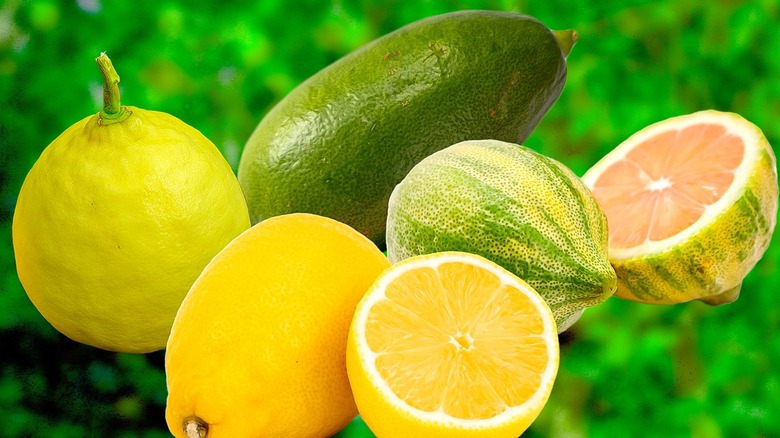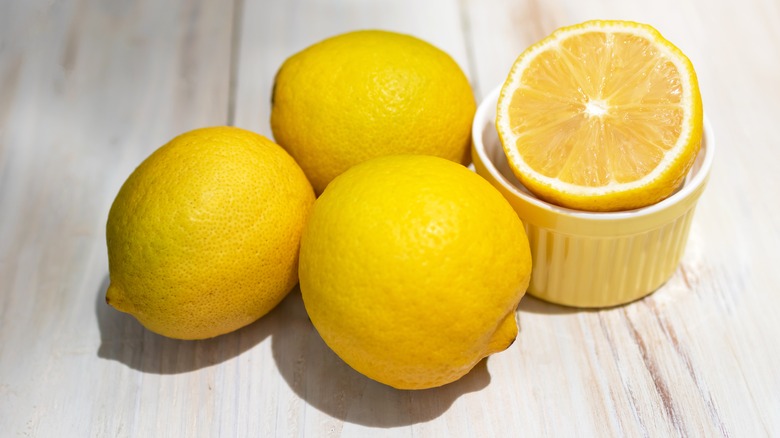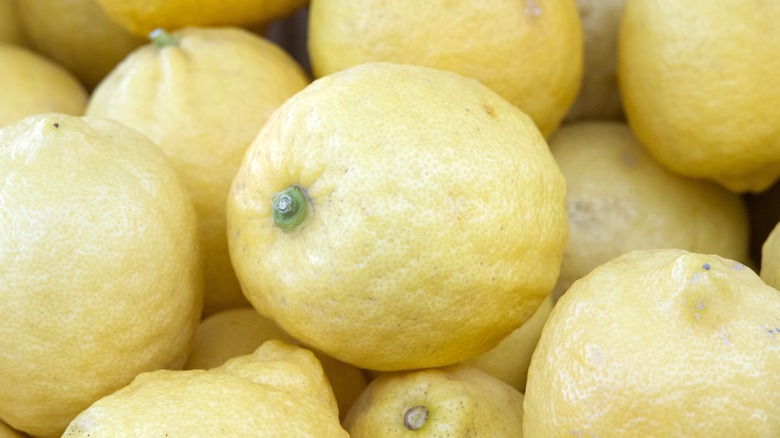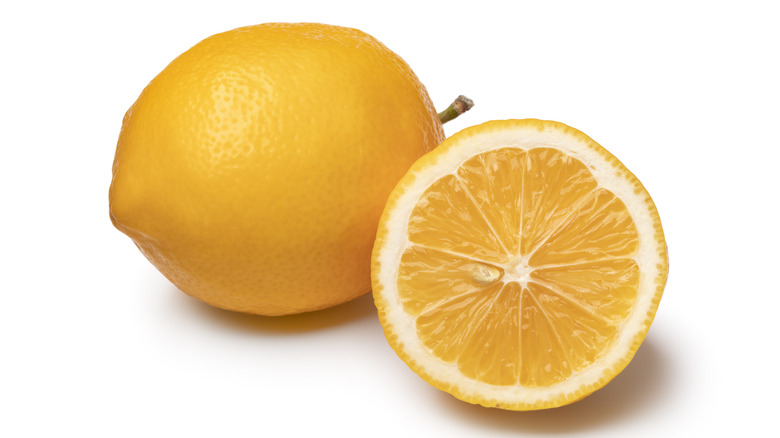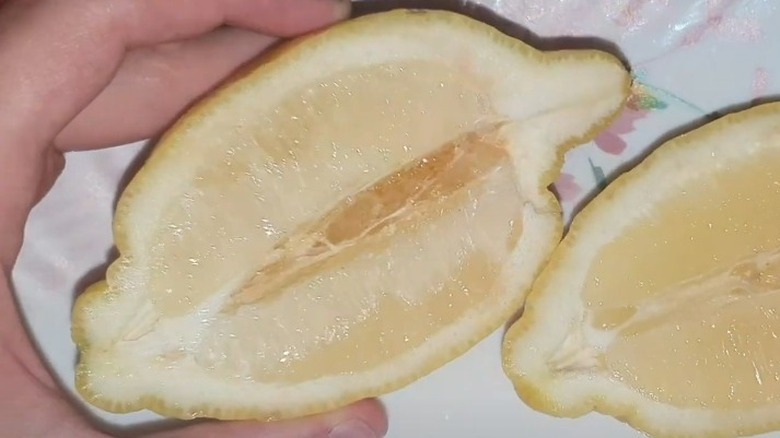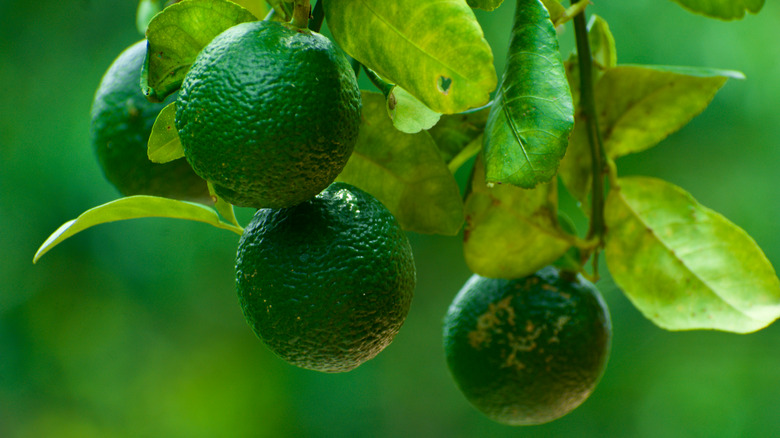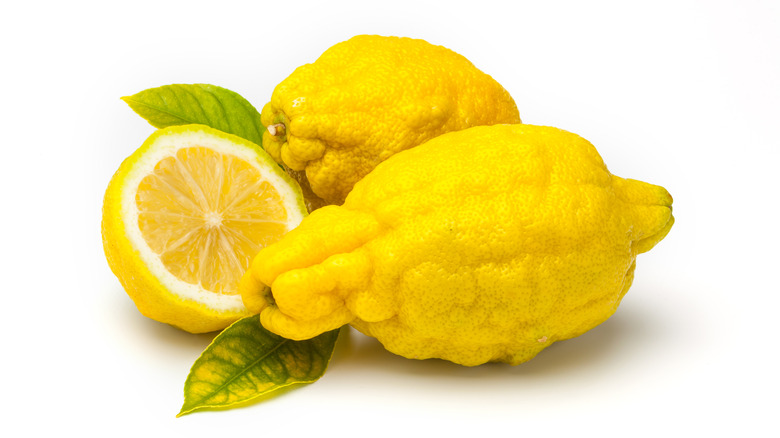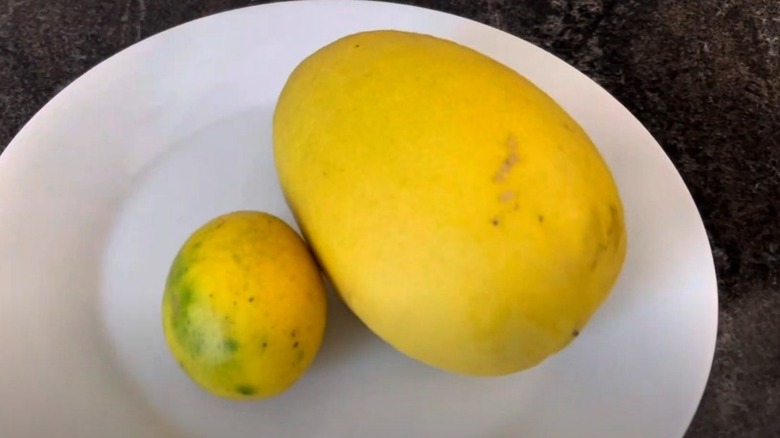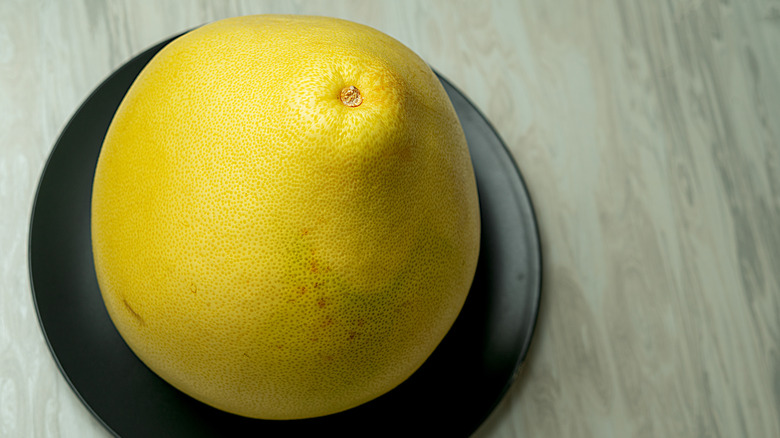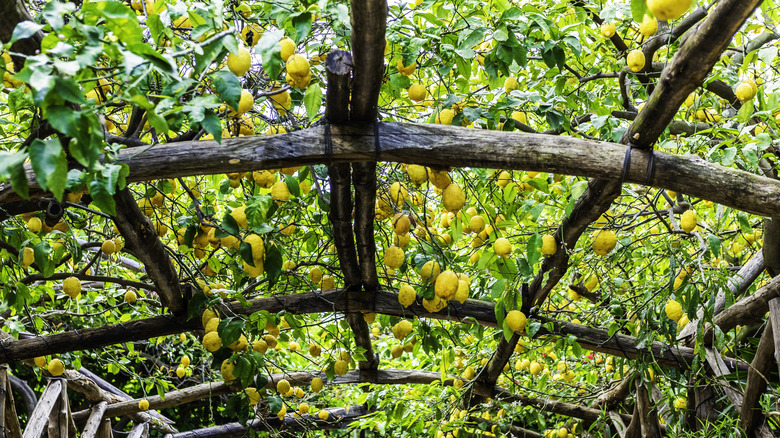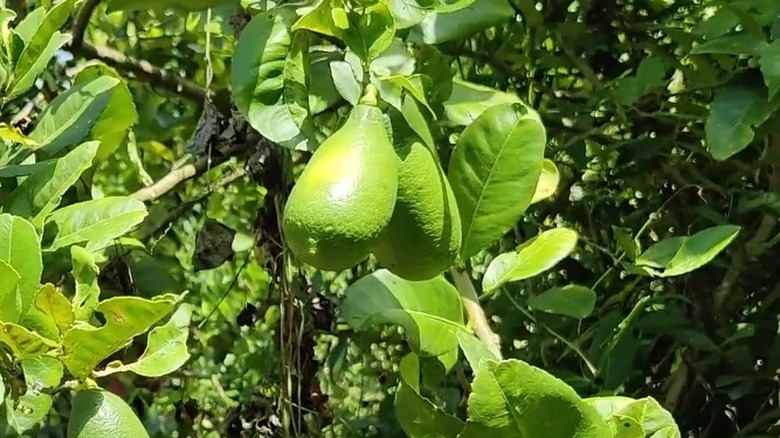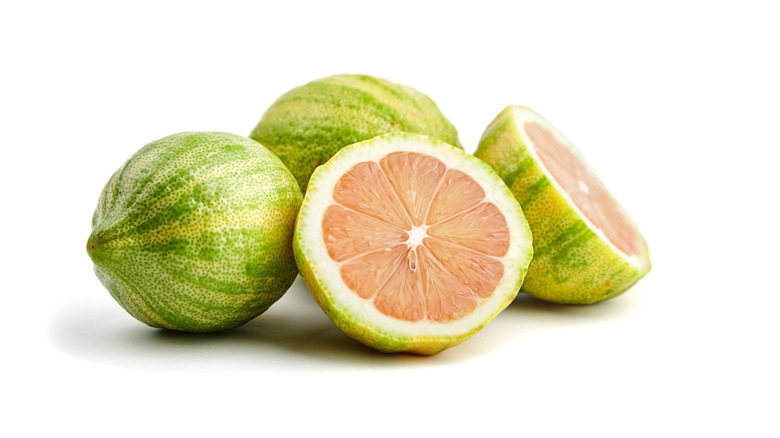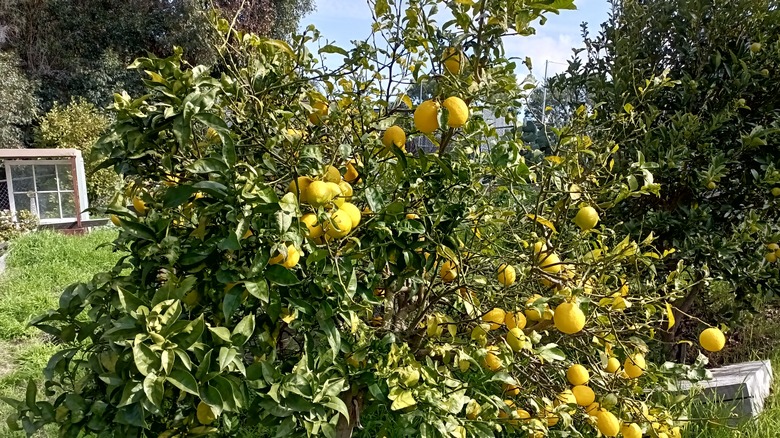12 Common Types Of Lemons And How They Are Different
Lemons — they're a fruit we cherish for their unmatched tart, tangy flavor and incredible versatility. Whether you're squeezing a splash of lemon juice into a sauce or dressing to add some brightness, grating that vibrant zest for a sweet, citrusy dessert, or adding a slice to a refreshing drink, these sunny little fruits seem to have a place in just about everyone's cooking routine.
When the time comes to grab some lemons at the store, you might be used to seeing the same handful of familiar varieties sitting on the shelves. But did you know that lemons actually come in a wide selection of types? Each one has unique characteristics that make it special, from subtle differences in taste to some quite noticeable variations in size, shape, and color. Understanding these differences can ensure you select the perfect lemon for every citrus-based recipe you make.
It's time to explore a wide assortment of these fruits and how they can best fit into your kitchen creations. From the quintessential Lisbon lemon that most of us recognize to the sweeter Meyer lemon or bumpy bush lemon (and even some weirdly and wonderfully shaped versions like Assam or the pink variegated), we've got it covered. So, get ready to become a lemon connoisseur and learn how to add the perfect citrus touch to your favorite foods and drinks.
1. Lisbon lemons
When you picture a classic lemon with a bright yellow color, an oval shape, and juicy flesh, you're likely thinking of a Lisbon lemon. These are among the most widely cultivated and recognized lemon varieties and are available in grocery stores all over the world. Lisbon lemons originate from Portugal, hence the name, though they're often grown in regions with Mediterranean climates such as California and Australia. This variety is sometimes confused with Eureka lemons, as they do share some similarities in appearance and taste; however, the Lisbon lemon has some distinct characteristics that set it apart.
One way to identify a Lisbon lemon is by looking at its skin. Color-wise, this fruit should be a vivid, sunny yellow. A Lisbon lemon's skin also tends to be relatively thin, and its flavor should be tart and tangy. These lemons are extremely versatile and well-suited to savory dishes like pasta and soups, as well as drinks like cocktails and lemonade. Their relatively thin skin makes squeezing the juice nice and easy, so they're perfect for slicing into wedges and adding to your plate as a garnish. Lisbon lemon crops tend to be very productive, hardy, and easy to grow, as they're particularly resistant to both hot and cold temperatures.
2. Eureka lemons
Eureka lemons are another extremely popular variety that you've likely encountered at the grocery store. Originating in California in the mid-19th century, these lemons have become one of the most commonly grown varieties in the world, particularly in the U.S., Australia, and South Africa.
Like Lisbon lemons, Eurekas also have the classic tart taste, yellow hue, and rounded, oblong shape, though their skin is sometimes a bit paler in color than Lisbons. The skin of an Eureka lemon also tends to be thicker, making it excellent for zesting. Again, these lemons can be used in numerous different ways, with their flavorful juice and zest being perfect ingredients or garnish for everything from fish dishes to lemon meringue pie.
Eureka lemon trees yield highly productive crops, and they can produce fruit all year round. In comparison to the Lisbon lemon tree, which is thorny with lots of dense foliage, the Eureka lemon tree is relatively thornless (which makes harvesting much easier). These lemons do require warm conditions in order to grow since they're a bit less resistant to extreme temperatures than Lisbon lemons.
3. Meyer lemons
Throughout most of the year, the lemon varieties you're most likely to encounter at the grocery store are Lisbon and Eureka; however, throughout winter and early spring, you might just come across their smaller, sweeter cousins. Meyer lemons have a rounder shape and deep yellow (or even orange) skin that's thin and smooth in texture. Originally from China, Meyer lemons are believed to be a cross between a regular lemon and a mandarin orange, which explains their distinctive taste and appearance.
This variety of lemon is prized for its unique taste, which is noticeably sweeter than Lisbon and Eureka lemons. The Meyer's lower acid content gives it this sweetness, and this makes it perfect for creating sweet treats like lemon curd, lemon sorbet, or candied peel. You can even toss raw segments of Meyer lemon into salads to add some brightness and tang without making the flavor overly acidic.
Since Meyer lemon trees are a bit smaller in size than Lisbon or Eureka varieties, it's entirely possible to grow your own Meyer lemons at home. The tree can be grown in a large pot and will require warm conditions, well-draining soil, and occasional fertilizing; however, bear in mind that it might take a couple of years for the tree to start producing fruit.
4. Verna lemons
Another type of lemon with a classic bright yellow hue and oval shape is the Verna lemon. These are primarily cultivated in Spain, where they're an extremely abundant variety. In fact, approximately 60% of lemons grown in Spain are Verna lemons. These lemons are known for their thick skin and slightly lower juice content. They are also a low acid fruit, so slightly less tart than Lisbon or Eureka lemons.
Verna lemons are perfect for recipes where the zest or peel takes center stage since each fruit will offer a generous amount with that lovely thick skin. The peel of the lemon is that part that contains the flavorful essential oils, so you can use this to infuse a deep citrus flavor into recipes like iced teas or limoncello. Vernas also tend to have very few seeds, which means less time spent picking them out when it comes to juicing.
A Verna lemon tree will fruit at least twice per year, typically in early spring and later summer. Though under particularly favorable conditions they will continue to fruit throughout the year. These trees are relatively thornless and thrive in areas with a Mediterranean climate and nutrient-rich soil. Vernas are typically picked at an immature stage before they are reached their (potentially very large!) full size.
5. Kagzi lemon
At first glance, you might assume that a Kagzi lemon is a lime. However, despite their appearance, these vibrant green fruits do fit firmly into the lemon category. Kagzi lemons, also known as Kagzi Nimbu, are a staple in Indian cuisine, where they bring a deep tartness and aromatic flavor to a range of dishes. These small, thin-skinned lemons are grown extensively in India, thriving in warm, tropical climates.
Kagzi lemons are incredibly juicy, with a tartness that is more pronounced than many other lemon varieties. This intense acidity makes them ideal for adding a punchy, zesty flavor to dishes. A popular Indian recipe made with Kagzi lemons is a simple, tangy pickle, which includes pieces of lemon peel, spices, salt, and sugar.
The Kagzi lemon tree is relatively small, bushy, thorny, and perfectly suitable for growing in many home gardens. Like most lemon varieties, it will grow best in a warm climate, preferring plenty of sun. The fruit itself is small and round, with a smooth, thin green skin, that becomes more yellow in hue as the fruit matures.
These fruits are often used in traditional medicine, with their high vitamin C and antioxidant content equipping them with a range of health benefits. Kagzi lemons have been used to combat various ailments, such as high blood pressure, and conditions of the skin and digestive system.
6. Bush lemon
Bush lemons, or rough lemons, are a unique and hardy variety native to Australia. They are often found growing wild in the subtropical regions of the country and are characterized by their thick, knobbly skin. Bush lemons are medium to large in size, with that distinctive bumpy rind ranging from bright yellow to deep orange when fully ripe. The thick skin contains plenty of essential oils, and inside, the fruit is juicy with a strong, tart flavor.
In terms of their culinary applications, Bush lemons are super versatile. Their tangy juice is ideal for making lemonade, dressings, and marinades, whilst the thick rind is perfect for making candied lemon peel or marmalade, where its aromatic qualities can really shine. They also possess high pectin levels, which makes their juice perfect for whipping up homemade jams and preserves. When bush lemons are ripe and plump, the skin is easy to peel, and some even opt to eat the whole fleshy inner part of the fruit raw, just like an orange!
Bush lemons are not as commonly found in large grocery stores but may be available to purchase in specialty stores. Or, if you live somewhere with a warm climate, you could grow your own. The Bush lemon tree is a vigorous grower, with thick, thorny branches and dense foliage. The trees are highly productive and can thrive in poor soil conditions, so make a great low-maintenance citrus tree for beginner gardeners.
7. Baboon lemon
The Baboon lemon (yep, that's really its name) is an intriguing and less common variety of this much-loved citrus fruit, with a distinct taste and unique appearance. Originating from Brazil, these lemons are particularly large in size and have thick, textured skin that's vivid yellow in color. Baboon lemons have a strong, tangy flavor that is often described as more floral than other common lemon varieties, with notes of lime too.
These lemons contain plenty of juice, though can be hard to squeeze due to their firm texture and large size. They're another versatile variety, with their zest and juice fitting perfectly into a range of sweet and savory recipes, from casseroles to cakes.
The Baboon lemon tree is known for its vigorous growth and resilience. It's a great choice for home gardeners looking for a hardy citrus tree since it's compact in size and easy to plant in a container. You'll just need to ensure the tree is protected if temperatures dip below freezing, which can be done by wrapping it in hessian or fleece. A baboon lemon tree should start producing fruit within one to two years, depending on how mature the buds are at the point of planting.
8. Ponderosa lemon
The largest fruit on our lemon lineup, the Ponderosa lemon is another rarer variety, that's thought to be a hybrid between a lemon and a citron. When fully matured, the largest Ponderosa fruits can weigh up to five pounds! As you can imagine, these lemons yield a pretty hefty amount of juice, which has a high acid content. They also contain many seeds and have thick, smooth skin. Their flavor is quite similar to that of more common lemon varieties.
Ponderosa lemons can be used in place of your standard Lisbon or Eureka lemon, but their substantial juice content makes them perfect for lemon-heavy recipes like dressings and marinades, or zesty lemon bars. Or, try stirring the juice into cocktails, teas, or syrups.
Despite the impressive size of the fruits, it's very much possible to grow Ponderosa lemons at home. However, those planted in smaller containers are often dwarf varieties, that won't reach such an extreme size. But, these trees will still thrive with plenty of sun and some well-drained, nutrient-rich soil. Ponderosa lemon trees are actually more commonly grown as ornamental plants since they produce gorgeous purple flowers. Wait patiently, though, and you'll be graced with those vibrant yellow fruits, which can take up to nine months to ripen.
9. Sorrento lemon
The Sorrento lemon, which of course gets its name from the stunning Italian coastal town, is the lemon variety you'll most commonly find along the Amalfi coast. These lemons are renowned for their exceptional flavor and are an essential ingredient in the production of the famous Italian liqueur — Limoncello. This variety is celebrated for its thick, aromatic rind and intensely fragrant zest.
Sorrento lemons boast a high acid content, so they're able to provide plenty of sharpness to any recipe. Squeeze them directly over freshly steamed salmon, zest them over a classic Italian pasta dish, or roast them alongside meats and vegetables to bring out their wonderful tangy flavor. But where this variety truly shines is in a homemade limoncello. To make this citrusy liqueur, the Sorrento lemon peel is steeped in vodka, which draws out all of those amazing essential oils. Then, a simple syrup is added to the mix, and after a final steep, the lemon peel can be drained out, leaving a smooth, sweet, and zesty limoncello.
These lemons are often grown in mountainside terraces in Sorrento and the surrounding regions, where the Mediterranean climate enables them to thrive. The trees can produce fruit all year round, but the peak harvest season is spring to fall.
10. Assam lemon
The staple lemon variety in the northeastern Indian state of Assam, the Assam lemon — or Kaji Nemu — has a unique appearance and flavor. These lemons are large in size, with a thin skin and more elongated, oblong shape than other common types. Their color can range from green to golden yellow, depending on ripeness, and they also have the added bonus of being seedless.
Assan lemons are integral to Assamese cuisine and are cherished for their distinctive flavor, with multiple culinary uses. They're a staple in many traditional dishes, such as soups, curries, and dals. Assam lemon slices are often served on the table for squeezing over meat, fish, and vegetables, enhancing the dishes with their bright, tangy taste. They also possess a distinct aroma with notes of bergamot and lime.
Beyond their culinary uses, Assam lemons are also known for their health benefits. Like other lemon varieties, they are rich in vitamin C and antioxidants, so eating them can help boost our immune systems and reduce our risk of developing cardiovascular disease. Their juice is commonly used in traditional medicine, serving as a treatment for a range of ailments from the common cold to indigestion.
The Assam lemon tree is robust and well-suited to the humid, tropical climate of the region, where they're often planted amongst other crops such as coconut, papaya, and banana trees. It can fruit throughout the year, though the peak season is fall and winter, from October through December.
11. Pink variegated lemon
The variety of this fruit with perhaps the most unique appearance is the Pink Variegated lemon. These small, round lemons are visually striking, with light green and yellow-striped skin, though when fully mature, they lose these stripes and become a pinkish shade. When sliced open, this flesh is also light pink, similar to that of a grapefruit. Pink variegated lemons originated from California in around 1930, and are actually a natural mutation of the common Eureka lemon.
Taste-wise, these beautifully stripy lemons are less sour than other common lemons, with a mild, floral flavor profile. They're fantastic for use in sweet treats such as lemon bars or lemon tarts, and despite the unique color of their flesh, their juice comes out similar in color to the usual pale yellow shade from other lemons. So they won't turn your desserts pink!
Pink variegated lemons are also well-appreciated for their ornamental value. The trees are bushy with glossy green and yellow leaves, with the stripy fruit making an attractive addition to any garden or patio. Plus, the fragrant white blossoms that appear before the tree fruits are another beautiful bonus.
12. Bearss lemon
The Bearss lemon is another classic version of the fruit, known for its substantial juice content, which has a tart and acidic taste. This variety originated in Florida in the 1950s. Bearss lemons are slightly larger than common varieties like Lisbon or Eureka lemons, have a high level of lemon oil in their skin, and contain very few seeds.
Being packed with juice, this variety is amazing for making lemonade or other lemon-based beverages. The sharp tartness of the Bearss lemon is perfect in recipes where you really need the acidity of the lemon to cut through other rich or sweet ingredients, such as lemon meringue pie or lemon buttercream frosting. The lemon oil-rich skin is also great for zesting. Use it in marinades, to garnish meat or fish, or in a zesty lemon cake.
The Bearss lemon tree is a particularly vigorous and hardy grower, producing more fruit than many other citrus trees. It needs plenty of sunlight but is well-suited to a variety of climates. It's easy enough to grow in a container that can be moved indoors during any particularly cold spells. This tree will fruit year-round, though the peak season for harvesting sits between July to December.
